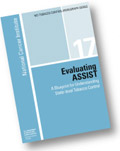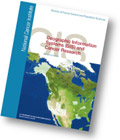|
 |
 |
NCI Listens and Learns |
 |
The cancer Biomedical Informatics Grid™ (caBIG™) is a voluntary cancer research network of infrastructure, tools, and ideas that enables individuals and institutions to share data to speed the delivery of innovative approaches for cancer prevention and treatment. NCI would like feedback from the advocacy community and the public about caBIG™.
- NCI has created a caBIG™ Web site specifically for public use at http://cabig.cancer.gov/. What ways might the site be strengthened to educate the patient advocacy community about the caBIG™ initiative?
- What benefits or concerns do cancer patients and advocacy organizations see related to the caBIG™ initiative?
To register and post comments, go to http://ncilistens.cancer.gov. |
|
CCR Staff Members Receive NIH World AIDS Day Award
Drs. Robert Yarchoan and Hiroaki (Mitch) Mitsuya of NCI's HIV and Aids Malignancy Branch in the Center for Cancer Research (CCR) will receive the first NIH World AIDS Day Award in recognition for their outstanding scientific contributions to HIV/AIDS research at NIH.
The announcement was made on December 1 to coincide with World AIDS Day. The award, sponsored by the NIH Office of AIDS Research and the National Institute of Allergy and Infectious Diseases, will be presented at a ceremony on January 11, 2007, at the NIH Institute and Center Directors meeting, where the recipients will also give a brief presentation on their research.
 NCI Releases New Tobacco Control Monograph
NCI Releases New Tobacco Control Monograph
NCI has released the 17th volume in the Tobacco Control Monograph series, Evaluating ASSIST: A Blueprint for Understanding State-Level Tobacco Control, which evaluates the American Stop Smoking Intervention Study for Cancer Prevention (ASSIST), one of the largest publicly funded tobacco-use prevention and control efforts in history.
Intended for health professionals, the monograph explains the conceptual framework and methodological approach used in the evaluation, a paradigm that will be useful in assessing future tobacco-use prevention and control efforts in the United States and around the world.
As one measure of its success, ASSIST interventions were adopted in numerous settings beyond ASSIST states, and tailored to state and local conditions. Aspects of the intervention strategy are now being applied to other public health issues, such as physical inactivity and obesity.
The monograph can be found at http://cancercontrol.cancer.gov/tcrb/monographs/17/. Print copies also are available free of charge.
NCI Introduces New Database
The Pathway Interaction Database, a collaborative project between NCI and the Nature Publishing Group, is a new resource aimed at providing insight into biological challenges by exploiting biomolecular interaction data. The database contains fully curated, network-level representations of interactions and pathways. A Web query interface supports simple browsing across predefined pathways, construction of larger networks around molecules and predefined pathways of interest, and analysis and visualization of lists of targeted molecules in the context of predefined and novel networks.
The "NCI-Nature Curated" section of the database currently contains 32 pathways and 1,327 interactions. Each of these pathways is verified by one or more experts in the field. All pathways and interactions are human.
CCR to Sponsor Cancer Prevention Think Tank
NCI's CCR is sponsoring "Cancer Prevention Think Tank 2006" on December 8 at NCI-Frederick.
The forum aims to identify and prioritize promising opportunities for high-impact cancer prevention research, and to enhance a collaborative response to these opportunities within CCR and with other NCI divisions, including the Division of Cancer Treatment and Diagnosis and DCP.
NCI and non-NCI speakers, plus two panels of experts, will address the following questions during a full-day's agenda: What are the best molecular targets for cancer prevention? Are there biomarkers that reliably predict the likelihood of cancer endpoints? Can molecularly targeted nutritional interventions be designed? What prevention studies should get high priority?
For more information, go to http://web.ncifcrf.gov/events/CancerPreventionThinkTank2006/default.asp.
Geographical Information Systems Inform Cancer Research
 A new brochure from DCCPS, Geographical Information Systems (GIS) and Cancer Research, provides an introduction to GIS for cancer researchers who do not currently use the technology in their work. The brochure includes information on how to use GIS in cancer research, applications for specific areas of research, resources available, research and funding opportunities, and examples of landmark studies. A new brochure from DCCPS, Geographical Information Systems (GIS) and Cancer Research, provides an introduction to GIS for cancer researchers who do not currently use the technology in their work. The brochure includes information on how to use GIS in cancer research, applications for specific areas of research, resources available, research and funding opportunities, and examples of landmark studies.
NCI can help researchers use GIS by providing tools to analyze spatial patterns and trends, and to evaluate the impact of cancer control interventions, as well as geographic, social, behavioral, genetic, and health care delivery factors on the cancer burden.
For more information on GIS, go to http://gis.cancer.gov. To order a copy of the brochure, go to https://cissecure.nci.nih.gov/ncipubs/search.asp.
|